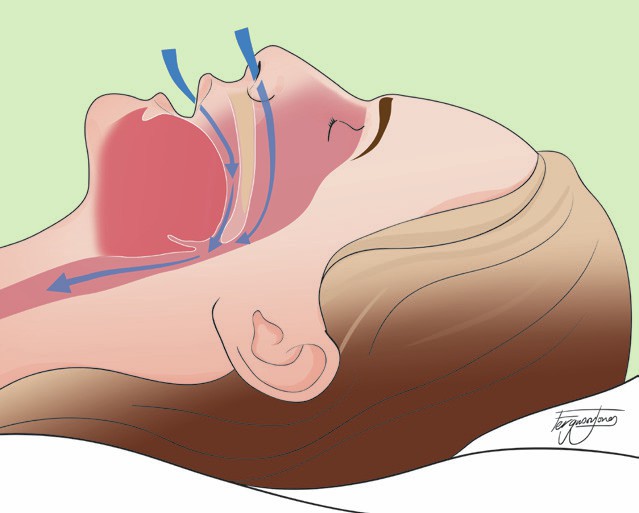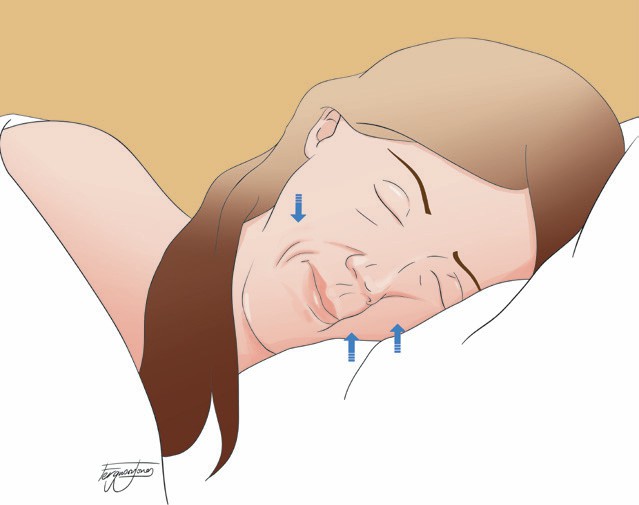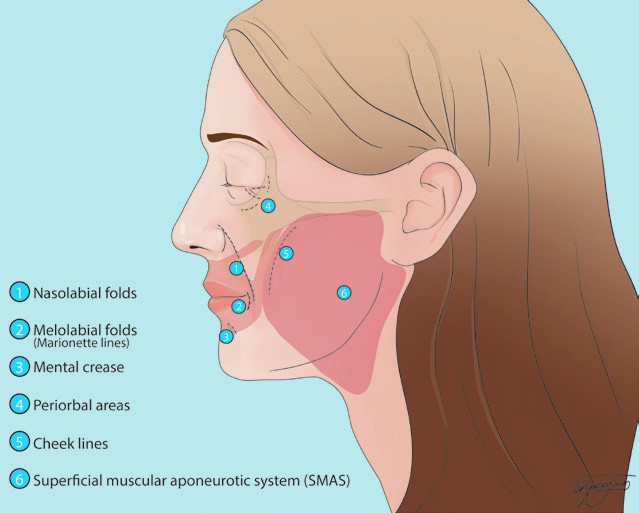SLEEP
In position
Dr Sara Samari discusses how the supine sleep position can be achieved and maintained throughout the entire night
Have you recommended your clients to sleep on their back after face and body procedures? How can you help them achieve and maintain this position to ensure the restful sleep needed for healing?
Before delving into this, this article will look at the known health benefits of restful sleep in the supine position.
Sleep, which occupies 33% of the human lifespan, is a complex physiological process that regulates mental, emotional, and physical performance. The quality of sleep is strongly influenced by habitual sleeping posture. Many studies have associated poor sleep quality with adverse health outcomes (e.g. cardiovascular disease, diabetes, inflammation, neurocognitive dysfunction and more).1
Scientists, doctors, and aestheticians agree that the supine position is the best posture to ensure restful, restorative sleep. Mimicking the upright posture in everyday life allows a neutral lordotic curve of the neck, reducing the pressure on the spine. Conversely, prone or lateral sleep forces the head to remain turned for hours, causing cervical intervertebral disk compression and musculoskeletal discomfort, leading to poor long-term sleep conditions with detrimental health effects.1-2 Moreover, biomechanical studies have confirmed that sleeping systems and choice of pillows are environmental factors that primarily affect the body’s comfort during sleep.3
In conclusion, the supine posture maintained through adequate support remains clinically the best posture to ensure high-quality sleep.
BENEFITS OF SUPINE SLEEP IN HEALTHY INDIVIDUALS

Fig. 1

Fig. 2a

Fig. 2b
The National Sleep Foundation has confirmed that a supine sleep position with support for the head and neck has countless health benefits.4
Advantages of supine sleep are a neutral alignment of the spine, which reduces tension on the head, shoulders, and hips, mitigating the onset of cervicogenic headaches, general musculoskeletal pain and promoting natural healing.
The prone and lateral positions disturb sleep quality by compressing different body parts. Pressure on the diaphragm hampers deep breathing, therefore inhibiting the activity of the parasympathetic nervous system, which stimulates relaxation, leading to increased stress and anxiety.
On the other hand, supine sleep allows for deep breathing promoting greater relaxation (Fig. 1). In addition, computational models have shown that prone or lateral sleep causes mechanical pressure on the skin5 by altering the fibromuscular layer of the superficial musculoaponeurotic system (SMAS), causing swelling and accentuation of wrinkles3-4(Fig. 2a, 2b).
By contrast, supine sleep promotes fluid drainage. Therefore, it prevents swelling of the face, formation of bags and dark circles, and even permanent wrinkles due to the lack of wrinkle-inducing pressure.6
BENEFITS OF SUPINE SLEEP: POST-OPERATIVE RECOMMENDATIONS
Harvard Professor, social psychologist Amy Cuddy rose to fame with her famous TED talk on body posture and its influence on social confidence, including her comments on the beneficial effect of a supine sleep posture.7
The benefits of the supine sleeping posture are even more remarkable in post-operative patients, where a restoring night of sleep is essential to enhance the healing process.
Rest in the early post-operative stages promotes healing and restoration of the damaged tissues.
Blood flow increases to damaged areas to provide oxygen and extra nutrients that stimulate recovery. Growth hormones are released to regulate inflammation and tissue repair. The increased demand for blood supply to the healing areas of the body can induce fluid accumulation and swelling.
Therefore, doctors suggest sleeping slightly elevated (20 to 30 degrees) in the supine position for several weeks8 following invasive and non-invasive procedures for the face and body to improve healing and lymphatic drainage (Table 1).
SLEEP AID: TO MAINTAIN THE SUPINE POSITION
In 2018, the Independent reported that only 8% of the population could comfortably sleep on their back. Therefore, doctors have reported that many patients have difficulty following their sleep recommendations.
The benefits of the supine sleeping posture are even more remarkable in post-operative patients
Difficulties arise from the discomfort of an unusual physical position and the emotional challenge of a more exposed way of sleeping. In adulthood, the supine position is the least common sleep position.
Waking Beauty Sleep System®, the present invention, overcomes these issues with specially designed support elements placed in such a way as to adapt to the needs of the neck, head, knees, and lower back, to assume and maintain the supine position throughout the night.
Which is the best way to maintain the supine sleeping position? Despite several studies in the literature, there is a lack of unequivocal findings, suggesting the need to explore what factors healthcare professionals should consider before recommending a supine sleeping system to their patients.
WHAT WOULD AN IDEAL SUPINE SLEEPING SYSTEM COMPRISE?
The three key aspects to consider when choosing the ideal supine sleeping system are the construction of the layers, the balance of the components, and the related emotional intelligence.
Any currently available pre-formed aids do not meet the physical needs or the emotional challenge required for a supine sleep, being unresponsive regarding temperature, heat transmission and moisture vapour adaptability. Furthermore, the physical nature of the aids and their sustainability are below par.
The ideal sleep support would be constructed with layers of natural and, where possible, ethically sourced materials.
Each layer serves a unique purpose by creating a structure that offers firm support and optimal cushioning.
All the components should be complementary and responsive to the needs of the individual. Altogether, they determine the capacity of the support elements to regulate and maintain the perfect bedding microclimate.9
Research has shown that REM sleep is more easily achieved in the thermoneutral zone, the optimum temperature that provides the body’s thermal comfort.9
However, the body’s thermoregulation is less active in restful conditions such as sleep. Thus, the microclimate generated by bedding and clothing determines the body’s thermal comfort zone.
Compared with cotton or synthetic materials, it has been found that sleeping on or under wool rather than any other material improves the quality and length of sleep at high (29°C) or low (17°C) temperatures.10
Wool can maintain body temperature consistently in all the sleep stages because it self-regulates, creating an insulating layer while drawing moisture away from the skin, thereby helping the body to cool down naturally.
Therefore, a wool pillow filling as the present invention is the most likely to ensure comfort and a constant body temperature.
The wool used for Waking Beauty Sleep System® was selected from one breed of sheep only with a particular micron measure processed to encourage resilience, mouldability and springiness.
The wool should be surrounded by natural and breathable materials for temperature regulation, particularly a lower thread count cotton. High thread count casings are presented as desirable to reduce air permeability and discourage moisture vapour transmission.
The fabric used for a coverslip is also key. The fabric used should have the best possible dimensional stability to achieve the individual support needed for the supine position. It also needs high counts of air permeability, moisture vapour transmission and facilitation of heat transference.
The correct choice of slip reduces skin and hair friction while maintaining smoothness and does not allow sebum re-transfer from the pillow, which can cause irritation and impurities to the skin.
High quality sleep generally manifests itself as a desire to remain in a comfortable position. Stillness can be achieved when all forms of anxiety, distress and unconscious irritation are removed. The emotional intelligence related to the sleep system should encourage stillness.
The ideal system for supine sleeping should allow the sleeper to remain comfortable, in one position, throughout the night for restful sleep that soothes mental, emotional, and physical performance.
Therefore, the properties of an ideal system to support supine sleep should be:
• The layered construction to support different musculoskeletal needs.
• The balance between the layers to improve moisture transmission, breathability, and heat control, enhancing the thermal physiological comfort of the body.10
• The emotional intelligence to provide for a deep, peaceful, and long sleep in the supine position.
Backed by rigorous scientific research, the Waking Beauty Sleep System®11 combines all the above in a unique layered format comprising five meticulously resourced, impeccably designed, ethically and sustainably sourced pillows to enable comfortable and supported supine sleeping.
See Waking Beauty at AM Live – stand B32 or visait wakingbeauty.co.uk.
DR SARA SAMARI
Dr Sara Samari is a biomedical researcher and writer with more than 10-years experience in academia.
Dr Samari’s main areas of expertise are biomedical science, musculoskeletal microbiology and physiology. She holds a PhD in Biomedicine and an MRes in Biomedical Research from Imperial College London. She has authored numerous scientific papers and works as a freelance medical writer and scientific consultant. She has also presented her published work at international conferences.
REFERENCES
1. M. A. Grandner, “Sleep, Health, and Society,” Sleep Med. Clin., vol. 12, no. 1, pp. 1–22, 2017.
2. M. Hirshkowitz et al., “National sleep foundation’s sleep time duration recommendations: Methodology and results summary,” Sleep Heal., vol. 1, no. 1, pp. 40–43, 2015.
3. J. Lei, P. Yang, A. Yang, Y. Gong, P. Shang, and X. Yuan, “Ergonomic Consideration in Pillow Height Determinants and Evaluation,” Healthcare, pp. 1–25, 2021.
4. E. Suni, “Best Sleeping Positions,” Sleep Foundation, pp. 1–7, 2021.
5. O. Kuwazuru, J. Saothong, and N. Yoshikawa, “Mechanical approach to ageing and wrinkling of human facial skin based on the multistage buckling theory,” Med. Eng. Phys., vol. 30, no. 4, pp. 516–522, 2008.
6. J. E. Fulton and F. Gaminchi, “Sleep lines,” Dermatologic Surg., vol. 25, no. 1, pp. 59–62, 1999.
7. A. J. C. Cuddy, C. A. Wilmuth, and D. R. Carney, “The Benefit of Power Posing Before a High-Stakes Social Evaluation,” Harvard Bus. Sch. Work. Pap., vol. 13, no. 27, pp. 1–18, 2012.
8. J. Elias and R. C. Semelka, “Post total hip replacement Commonly asked questions by patients -Orthopaedic Surgery -Patient Information. The Rotherham NHS Foundation Trust,” Heal. Care Reform Radiol., pp. 64–85, 2013.
9. U. R. Amrit, “Bedding textiles and their influence on thermal comfort and sleep,” Autex Res. J., vol. 7, no. 4, pp. 252–254, 2007.
10. M. Shin, M. Halaki, P. Swan, A. H. Ireland, and C. M. Chow, “The effects of fabric for sleepwear and bedding on sleep at ambient temperatures of 17°C and 22°C,” Nat. Sci. Sleep, vol. 8, pp. 121–131, 2016.
11.
www.wakingbeauty.co.uk